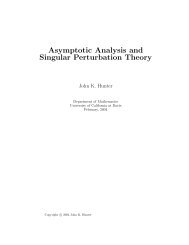The Riemann Integral
The Riemann Integral
The Riemann Integral
Create successful ePaper yourself
Turn your PDF publications into a flip-book with our unique Google optimized e-Paper software.
48 1. <strong>The</strong> <strong>Riemann</strong> <strong>Integral</strong><br />
Principal value integrals arise frequently in complex analysis, harmonic analysis,<br />
and a variety of applications.<br />
Example 1.83. Consider the exponential integral function Ei given in Example<br />
1.60,<br />
∫ x<br />
e t<br />
Ei(x) =<br />
−∞ t dt.<br />
Ifx < 0, the integrandis continuous for−∞ < t ≤ x, and the integralis interpreted<br />
as an improper integral,<br />
∫ x<br />
e t ∫ x<br />
e t<br />
dt = lim<br />
t r→∞<br />
−r t dt.<br />
∞<br />
This improper integral converges absolutely by comparison with e t , since<br />
e t<br />
∣ t ∣ ≤ et for −∞ < t ≤ −1,<br />
and<br />
∫ −1<br />
−∞<br />
e t dt = lim<br />
r→∞<br />
∫ −1<br />
−r<br />
e t dt = 1 e .<br />
If x > 0, then the integrand has a non-integrable singularity at t = 0, and we<br />
interpret it as a principal value integral. We write<br />
∫ x<br />
−∞<br />
e t<br />
t dt = ∫ −1<br />
−∞<br />
e t<br />
t dt+ ∫ x<br />
−1<br />
e t<br />
t dt.<br />
<strong>The</strong> first integral is interpreted as an improper integral as before. <strong>The</strong> second<br />
integral is interpreted as a principal value integral<br />
∫ x<br />
e t (∫ −ǫ<br />
e t ∫ x<br />
p.v. dt = lim<br />
−1 t ǫ→0 + −1 t dt+ e t )<br />
ǫ t dt .<br />
This principal value integral converges, since<br />
p.v.<br />
∫ x<br />
−1<br />
e t<br />
t dt = ∫ x<br />
−1<br />
e t −1<br />
t<br />
dt+p.v.<br />
∫ x<br />
−1<br />
∫<br />
1 x<br />
t dt =<br />
−1<br />
e t −1<br />
t<br />
dt+lnx.<br />
<strong>The</strong> first integral makes sense as a <strong>Riemann</strong> integral since the integrand has a<br />
removable singularity at t = 0, with<br />
( e t )<br />
−1<br />
lim = 1,<br />
t→0 t<br />
so it extends to a continuous function on [−1,x].<br />
Finally, if x = 0, then the integrand is unbounded at the left endpoint t =<br />
0. <strong>The</strong> corresponding improper or principal value integral diverges, and Ei(0) is<br />
undefined.<br />
Example 1.84. Let f : R → R and assume, for simplicity, that f has compact<br />
support, meaning that f = 0 outside a compact interval [−r,r]. If f is integrable,<br />
we define the Hilbert transform Hf : R → R of f by the principal value integral<br />
Hf(x) = 1 π p.v. ∫ ∞<br />
−∞<br />
f(t)<br />
x−t dt = 1 (∫ x−ǫ<br />
π lim<br />
ǫ→0 + −∞<br />
∫<br />
f(t) ∞<br />
x−t dt+<br />
x+ǫ<br />
f(t)<br />
x−t dt )<br />
.
















